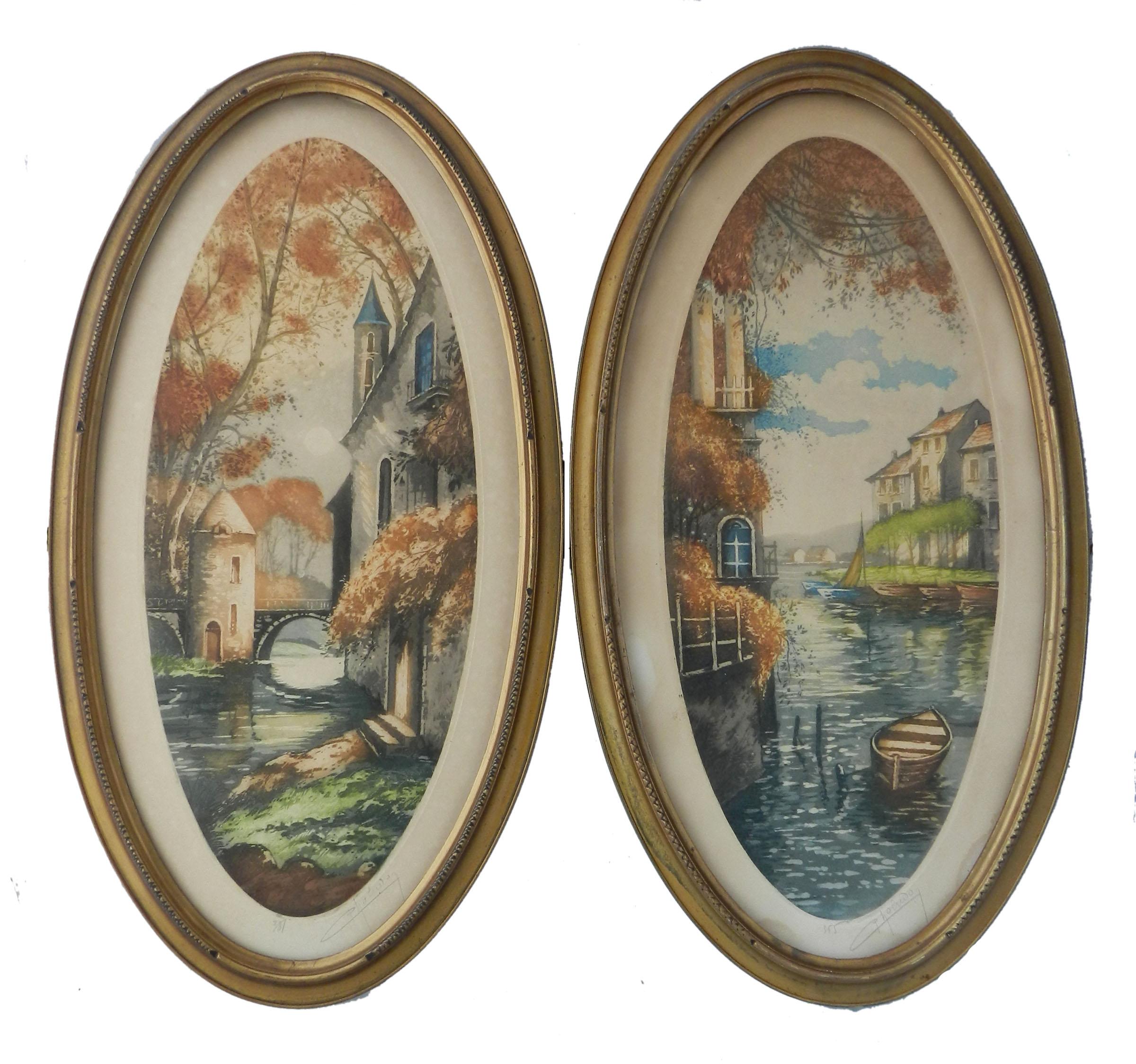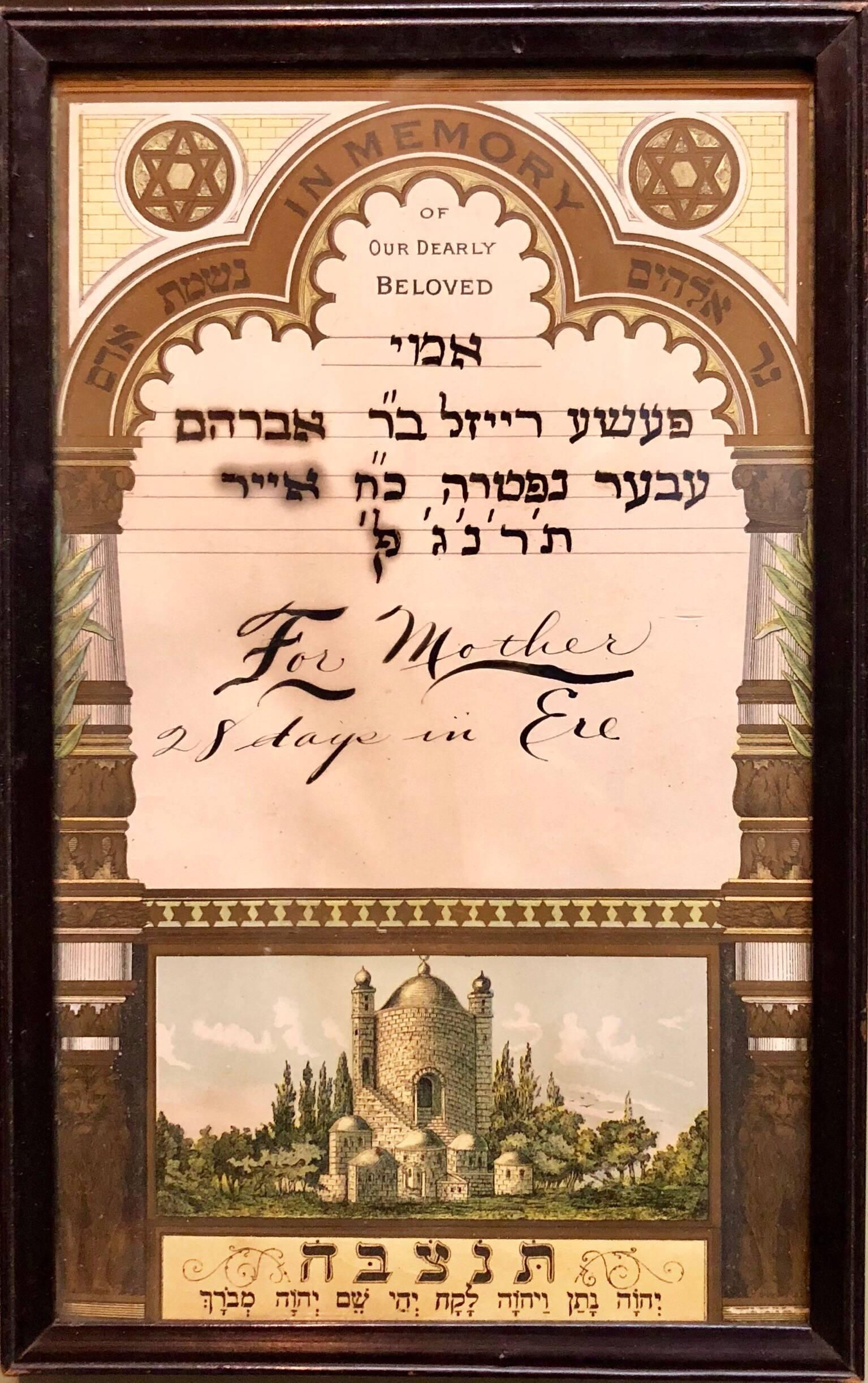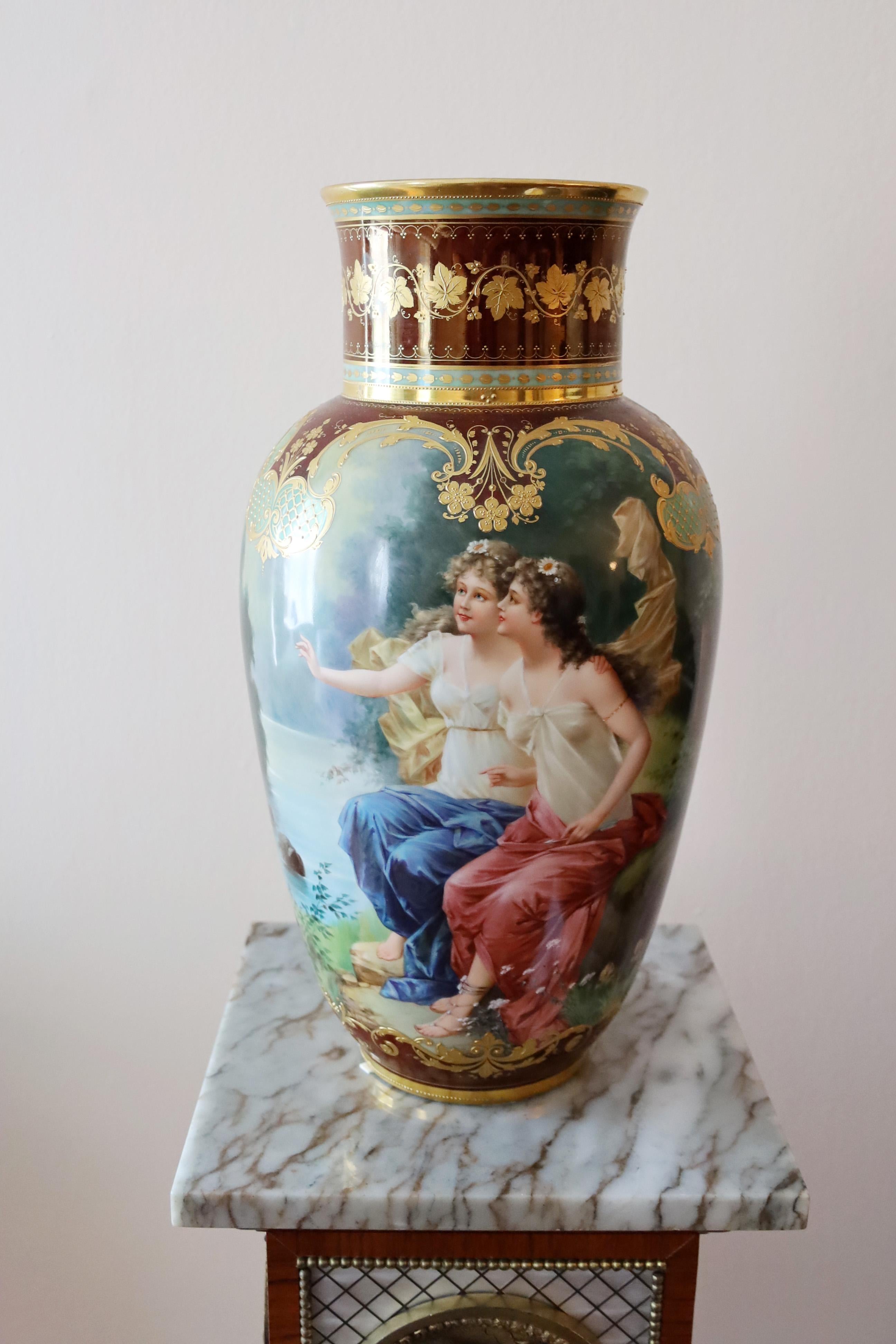Items Similar to Stanford White Newcomb-Macklin picture frame pair
Want more images or videos?
Request additional images or videos from the seller
1 of 18
Stanford White Newcomb-Macklin picture frame pairca. 1915
ca. 1915
About the Item
PERIOD FRAMES c. 1915 American painting frame pair, (earlier Stanford White design), Newcomb-Macklin, New York makers, gold leaf, gray bole, gesso, on cast ornament on wood. Flat panel profile with alternating rows of applied ornament. These matching identical examples have good original gilding. Sight size 21-1/2” x 25-1/2”; Rabbet size 22-1/4" x 26-1/4". Depth 1". Overall size 28-7/8 x 32-7/8". Note: Stanford White’s original design of this frame model, circa 1880, was fabricated of hand-carved wood by Joseph Cabus, New York.
“During his lifetime, Stanford White closely guarded permissions for fabrication of his frame designs. Following his untimely death in 1906, the Newcomb-Macklin Company of New York and Chicago acquired the molds and rights to reproduce White’s frame designs and began making copies under its own name in 1912.
- Creation Year:ca. 1915
- Dimensions:Height: 32.88 in (83.52 cm)Width: 28.88 in (73.36 cm)Depth: 1 in (2.54 cm)
- Medium:
- Movement & Style:
- After:Stanford White (1853-1906, American)
- Period:
- Condition:
- Gallery Location:Wilton Manors, FL
- Reference Number:1stDibs: LU245210414952
About the Seller
4.9
Gold Seller
These expertly vetted sellers are highly rated and consistently exceed customer expectations.
Established in 2007
1stDibs seller since 2015
328 sales on 1stDibs
Typical response time: 2 hours
- ShippingRetrieving quote...Ships From: Wilton Manors, FL
- Return PolicyA return for this item may be initiated within 7 days of delivery.
More From This SellerView All
- Untitled (Outsider Art Surrealist Figural Sculpture)Located in Wilton Manors, FLRocco Monticolo (b. 1931). Untitled, 2022. Found antique object, wood, paint. Signed on reverse of face. Monticolo was born in Italy in 1931 and came to America in 1946. He joined ...Category
2010s Surrealist Sculptures
MaterialsSteel
- Standing FigureLocated in Wilton Manors, FLTom Cramer (b.1960). Standing Figure, 1998. Carved wood and polymer paint. Measures 17.5 inches high. Excellent condition. Signed and dated under base. Tom Cramer is an American artist working in Portland, Oregon noted for his intricately carved and painted wood reliefs and ubiquity throughout the city of Portland. Often called the unofficial Artist Laureate of Portland,[2] Cramer is one of the most visible and successful artists in the city. The influences on his work are both organic and technological. He is widely collected and is in many prominent west coast museum and private collections. He is in the permanent collections of the Portland Art Museum[3] in Portland Oregon, the Halle Ford Museum in Salem Oregon, the Jordan Schnitzer Museum in Eugene, Oregon, the Boise Art Museum in Idaho. Cramer made a name for himself in the 1980s and 1990s becoming a bridge between historical Oregon artists like Clifford Gleason and Milton Wilson...Category
Late 20th Century Neo-Expressionist Figurative Sculptures
MaterialsWood, Latex
- Standing FigureLocated in Wilton Manors, FLTom Cramer (b.1960). Standing Figure, 1980. Carved wood and polymer paint. Measures 11.5 inches high. Excellent condition. Signed and dated under base. Tom Cramer is an American artist working in Portland, Oregon noted for his intricately carved and painted wood reliefs and ubiquity throughout the city of Portland. Often called the unofficial Artist Laureate of Portland,[2] Cramer is one of the most visible and successful artists in the city. The influences on his work are both organic and technological. He is widely collected and is in many prominent west coast museum and private collections. He is in the permanent collections of the Portland Art Museum[3] in Portland Oregon, the Halle Ford Museum in Salem Oregon, the Jordan Schnitzer Museum in Eugene, Oregon, the Boise Art Museum in Idaho. Cramer made a name for himself in the 1980s and 1990s becoming a bridge between historical Oregon artists like Clifford Gleason and Milton Wilson...Category
Late 20th Century Neo-Expressionist Figurative Sculptures
MaterialsWood, Latex
- Standing FigureLocated in Wilton Manors, FLTom Cramer (b.1960). Standing Figure, 1988. Carved wood and polymer paint. Measures 11.5 inches high. Excellent condition. Signed and dated under base. Tom Cramer is an American artist working in Portland, Oregon noted for his intricately carved and painted wood reliefs and ubiquity throughout the city of Portland. Often called the unofficial Artist Laureate of Portland,[2] Cramer is one of the most visible and successful artists in the city. The influences on his work are both organic and technological. He is widely collected and is in many prominent west coast museum and private collections. He is in the permanent collections of the Portland Art Museum[3] in Portland Oregon, the Halle Ford Museum in Salem Oregon, the Jordan Schnitzer Museum in Eugene, Oregon, the Boise Art Museum in Idaho. Cramer made a name for himself in the 1980s and 1990s becoming a bridge between historical Oregon artists like Clifford Gleason and Milton Wilson...Category
Late 20th Century Neo-Expressionist Figurative Sculptures
MaterialsWood, Latex
- Standing FigureLocated in Wilton Manors, FLTom Cramer (b.1960). Standing Figure, 1998. Carved wood and polymer paint. Measures 10.25 inches high. Excellent condition. Signed and dated under base. Tom Cramer is an American artist working in Portland, Oregon noted for his intricately carved and painted wood reliefs and ubiquity throughout the city of Portland. Often called the unofficial Artist Laureate of Portland,[2] Cramer is one of the most visible and successful artists in the city. The influences on his work are both organic and technological. He is widely collected and is in many prominent west coast museum and private collections. He is in the permanent collections of the Portland Art Museum[3] in Portland Oregon, the Halle Ford Museum in Salem Oregon, the Jordan Schnitzer Museum in Eugene, Oregon, the Boise Art Museum in Idaho. Cramer made a name for himself in the 1980s and 1990s becoming a bridge between historical Oregon artists like Clifford Gleason and Milton Wilson...Category
Late 20th Century Neo-Expressionist Figurative Sculptures
MaterialsWood, Latex
- Influence of Red (male portrait)By Gilbert LewisLocated in Wilton Manors, FLGilbert Lewis (b.1945). Influence of Red (male portrait), ca. 1990s. Oil on masonite panel, 16 x 20 inches. Signed upper right. Excellent condition. Measures 18 x 22 inches in custom gold leaf float frame. Original gallery labels affixed on verso. Provenance: estate of the artist. Artist statement: Figurative art is a vital active process. The image has its own meaning; not storytelling, not just a picture of a face or a flower. Neither is it simply an exercise in the arrangement of shapes or colors. I want to translate my immediate impression into paint to present the image of an outstretched branch of flowers or a face – direct and simple. My art reflects human concerns expressed symbolically, through fantasy and in a more concrete manner in the process of making the representation itself. Art is my response to the image, the end result of an active process of exploration of the limits of the paint on paper within the confines of representation. The painting of a face is not just a face. My feelings are expressed through these images. My paintings speak to anyone in touch with their own humanity; to anyone else my art may be dismissed as “to personal”. Biography: Gilbert Braddy Lewis born September 25, 1945 in Hampton, Va. Son of David Blake Lewis (born in Atlanta, Ga.) and Gladys Louise Braddy [Lewis] (of Sanford, Fl.); brother of David Blake Lewis (Jr.) and Linda Lewis [Hunter]. The family resides at 3 South Linden Street, Hampton, Va. 1953 until 1962 “I studied from the age of seven, in Virginia, with two well-known Tidewater artists, Jean Craig and the late Allan Jones. The teaching methods of carefully observed studies from nature in charcoal or tempra paint, derived, of course, from the original French academic model, conveyed its impact on my early development; however, my eye and consciousness were mostly activated by the reproductions on the studio wall of works by Botticelli, Da Vinci, and Michelangelo.” Gilbert Lewis in Contemporary Philadelphia Artists: A Juried Exhibition, (Philadelphia Museum of Art 2000), p. 145 1963-68 Studies at Pennsylvania Academy of the Fine Arts with Franklin Watkins, Hobson Pittman, Morris Blackburn, and Walter Stuempfig. While a student at PAFA he shares apartment [261 South 21st Street] with PAFA students, Jody Pinto and Barbara Sosson. In 1967 he receives PAFA’s: Bergman Prize in Painting; M. Herbert Syme Prize; and Samuel Cresson Memorial Travelling Scholarship. The latter award enables Lewis to travel to Europe during the summer of 1967 where he visits museums. “In 1967, after having seen the Italian master’s work while on scholarship from the Pennsylvania Academy, I was to realize my great influences and to discover the earlier Sienese masters whose clarity and energy still move me.” Gilbert Lewis in Contemporary Philadelphia Artists: A Juried Exhibition, (Philadelphia Museum of Art 2000), p. 145 1968 Horizontal painting [of an interior with a seated woman and cat by a large window] reproduced in black and white in school catalog for Pennsylvania Academy of the Fine Arts 1968-1969, p. 24. Other students whose works are reproduced include Clayton Anderson, Barkley...Category
1990s Realist Portrait Paintings
MaterialsMasonite, Oil
You May Also Like
- Reclaimed Waxed Warehouse Shutters, Soho, NY 1999 Home FurnishingLocated in Hudson, NYA NEW COLLABORATION Tina West + Tucker Robbins 2020 The Robin Rice Gallery is pleased to present a photographic exhibition by Tina West, featuring a special new collaboration betwe...Category
2010s Aesthetic Movement More Art
MaterialsIron
- Pair French Chateau Landscape Signed by Artist Lithograph c1920Located in FRPair of Landscape with Chateau signed by artist Lithograph These have their own frame of the time slightly distressed and glorious Good vintage conditionCategory
1920s Aesthetic Movement Landscape Prints
MaterialsLithograph
- Pair French Chateau Landscape (1) Signed by Artist Lithographs c1920Located in FRPair of Landscape with Chateau (1) signed by artist Lithograph c1920 These have their own frame of the time slightly distressed and glorious Good vintage conditionCategory
1920s Aesthetic Movement Landscape Prints
MaterialsLithograph
- Rare Judaica 1893 Jewish Yizkor Memorial Plaque Hebrew English ChromolithographLocated in Surfside, FLA rare Judaic memorial piece for mother.Category
Late 19th Century Aesthetic Movement More Prints
MaterialsLithograph
- MONUMENTAL ROYAL VIENNA PORTRAIT VASE PORCELAIN HANDPAINTED 19TH CENTURYLocated in Forest Hills, NYMONUMENTAL ROYAL VIENNA PORTRAIT VASE - PORCELAIN - HAND PAINTED YOUNG GIRL Inscibed "Erwartung" , Germany, and The Royal Vienna porcelain s...Category
1980s Aesthetic Movement More Art
MaterialsPorcelain
- Rare Palestine Antique Hebrew Judaica Yahrzeit Synagogue Sign Memorial PlaqueLocated in Surfside, FLCirca 1890-1920. This Neoclassical, Judaic, Egyptian revival, Orientalist Mizrach sign, was produced in British Mandate Palestine by the chromolithograph process at the beginning of the 20th century. It pictures vignettes of holy places. with a hand written memorial. It was for the Tzedakah charity fund for the century-old institutions in Jerusalem: The great "Torah Center Etz Chaim"; a Free Kitchen for poor children and orphans; the famous Bikur Cholim Hospital with its dispensaries and clinics and the only Home for Incurable Invalids in Eretz Israel. They also worked with Arthur Szyk and Alfred Salzmann.. The A.L. Monsohn Lithographic Press (Monzon Press, Monson Press, דפוס אבן א"ל מאנזאהן, דפוס מונזון) was established in Jerusalem in 1892 by Abraham-Leib (or Avrom-Leyb) Monsohn II (Jerusalem, c.1871-1930) and his brother Moshe-Mordechai (Meyshe-Mordkhe). Sponsored by members of the Hamburger family, the brothers had been sent to Frankfurt, Germany in 1890 to study lithography. Upon returning to Jerusalem in 1892 with a hand press, they established the A.L. Monsohn Lithographic Press in the Old City of Jerusalem. According to the Information Center for Israeli Art A.L. Monsohn "created complex decorations for documents and oriental calendars that combined the tradition of Jewish art with modern printing techniques such as photographic lithography, raised printing and gilding." The founders of the Monsohn press produced Jewish-themed color postcards, greeting cards, Jewish National Fund stamps, and maps documenting the evolution of the Jewish settlement in Eretz Israel in the nineteenth-twentieth centuries; religious material such as decorative plaques for synagogues, portraits of Old Yishuv rabbis such as Shmuel Salant, Mizrah posters indicating the direction of prayer for synagogues, memorial posters, and posters for Sukkot booths; color frontispieces for books such as Pentateuch volumes and the early song collections of Abraham Zvi Idelsohn (e.g., Shire Zion, Jerusalem 1908); artistic wedding invitations; and labels, packaging and advertisements for the pioneering entrepreneurs of Eretz Israel. The texts appearing in the Monsohn products were in several languages: Hebrew, Arabic, Yiddish, English, German (e.g., a c1920 trilingual Hebrew-English-Arabic "Malaria Danger" broadside warning the public of mosquitoes spreading malaria). Many of the brilliantly colored postcards and maps can be seen online as can the artistic invitations to his children's weddings which Monsohn published in the Jerusalem Hebrew press. For years, the Monsohn (later, Monson/Monzon) Press was considered the best and most innovative in the country—pioneering in such techniques as gold-embossing and offset printing, among others. Early items for tourists included collections of Flowers of the Holy Land (c. 1910–1918)—pressed local flowers accompanied by scenes from the Eretz Israel countryside and relevant verses from the Bible, edited by Jsac Chagise (or Itzhak Haggis), an immigrant from Vitebsk, and bound in carved olive wood boards. Shortly after World War I Monsohn (now spelled מונזון) used zincography to produce the prints included in the Hebrew Gannenu educational booklets for young children illustrated by Ze'ev Raban of the Bezalel Academy of Art and Design and printed in Jerusalem by Hayim Refael Hakohen (vol. 1, 1919; vols. 2–3, 1920). In 1934 Monsohn moved into the new, western part of Jerusalem, in a shop with four presses and 30 workers, including Abraham-Leib's sons, David, Yosef, Moshe and Shimon, and his daughter Raytse's husband, Abraham Barmacz. The concern did business with all sectors of the city's population, including Arabs, for whom they printed in Arabic. Among their clients were members of the Ginio, Havilio, and Elite families, and Shemen, Dubek, and other renowned national brands, manufacturing products such as wine, candies, oil, and cigarettes. They also printed movie and travel posters, and government posters, postcards and documents, hotel luggage labels...Category
Early 20th Century Aesthetic Movement More Art
MaterialsLithograph
Recently Viewed
View AllMore Ways To Browse
White Carved
Framing Model
Framed Art Pair
Pair Of Framed Art
Antique Frame White
Antique White Frame
Framed Art In Pairs
White Carved Wood
White Molded
White Ornament
Antique American White
American Antique White
Carved Wood Art Framed
Pair Framed Panel
Antique White Ornaments
22x28 Frame
Antique Frames Chicago
Gold Leaf Art Pair





